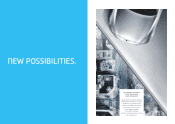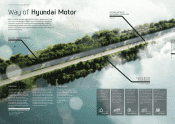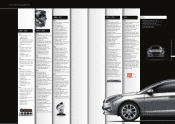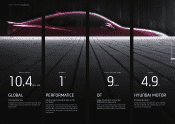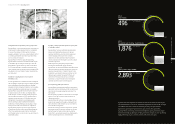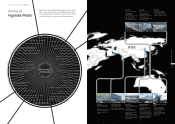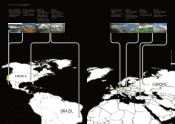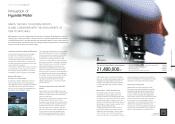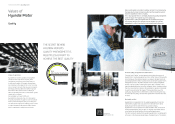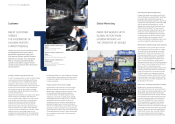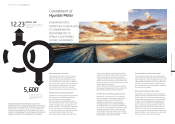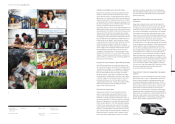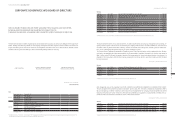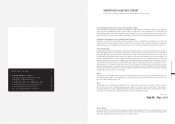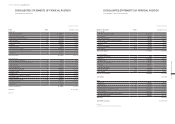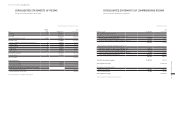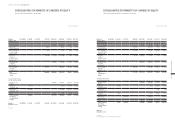Hyundai 2014 Annual Report Download - page 32
Download and view the complete annual report
Please find page 32 of the 2014 Hyundai annual report below. You can navigate through the pages in the report by either clicking on the pages listed below, or by using the keyword search tool below to find specific information within the annual report.
PAVING THE PATH TO HYUNDAI MOTOR’S
GLOBAL LEADERSHIP WITH THE DEVELOPMENT OF
NEW TECHNOLOGIES
The Namyang Technology Research Center is by far
the largest R&D center, and consists of a planning
center, a design center, a powertrain center, wind
tunnel facilities, collision testing facilities, and
a comprehensive proving ground. Over 11,000
researchers are working at the center, developing
and testing new models. The Namyang Technology
Research Center serves as the center of Hyundai
Motor’s global R&D network, linking overseas
R&D centers with Hyundai Motor’s Korea-based
capacity. The Mabuk Environmental Technology
Center is largely responsible for the development of
the hydrogen fuel cell car and other leading green
technologies. The Korea Central Research Institute
is responsible for developing new technologies
including environmental, alternative energy,
intelligent safety features, convenience features
and new materials.
Engaging the global market with a global R&D
network
Hyundai Motor has established R&D centers in key
regions of the world in order to better understand the
different environments and customer preferences,
which vary significantly.
Hyundai Motor
’
s overseas research network consists
of Beijing Hyundai Technical Center in Yantai,
Shandong province, Hyundai America Technical Center
in Ann Arbor, Michigan state, Hyundai Motor Europe
Technical Center in Frankfurt, Germany, Hyundai
Motor Japan R&D Center in Yokohama, Japan and
Indian Technical Research Center in Hyderabad. Each
overseas research center directly communicates
with the Namyang Technology Research Center in
Korea. Overseas R&D centers are responsible for
understanding regional markets and technological
trends and using their understanding to support the
development of localized models. Working on the
frontline, overseas R&D centers play a pivotal role
in supporting Hyundai Motor to become a leading
automaker.
Design centers : Leading the global trend
Improving the quality of design is an essential
requirement in becoming a global leader in the
premium brand market. The Namyang Design Center
is Hyundai Motor’s main design center and it has been
continuously increasing its capacity so that it can
become a world-leading automobile design center. It is
the birthplace of ‘Fluidic Sculpture’, Hyundai Motor’s
highly acclaimed design philosophy.
The Namyang Design Center is also the center of
Hyundai Motor’s global research network which
collaborates with Hyundai Motor’s overseas design
centers in Europe, the US, India, China and Japan.
Overseas design centers are responsible for learning
about the lifestyle of customers in their respective
markets and developing refreshing designs that deliver
high levels of satisfaction to the target customers.
World class proving grounds
Hyundai Motor has built proving grounds in both
Korea and overseas where the handling, ride quality,
high speed driving and durability of new models can
be tested. Hyundai Motor has two proving grounds
in Korea ; one at the Namyang Technology Research
Center which is one of the most comprehensive proving
grounds in the world and another at the Ulsan plant
which was the first proving ground built in Korea.
Hyundai Motor’s US proving ground in California is the
third largest proving ground established by a non-
domestic brand. It is carefully designed to emulate the
various driving conditions found in the US, playing an
integral role in Hyundai Motor’s localization effort
.
Leading the market by strengthening R&D capacity
As the automotive industry moves towards green
and smart cars, the ability to develop ‘green’
and ‘smart’ cars has become a key indicator of a
company’s R&D capacity. Determined to become a
market leader, Hyundai Motor has created a long-
term R&D investment plan and begun to make large
scale investments in key areas.
The expansion of R&D facilities and the recruitment
of new R&D staff is under way in order to secure
the necessary capacity and infrastructure for the
development of game changing new technologies.
Domestic R&D network :
Birth place of new technologies
Hyundai Motor’s domestic R&D network consists of
three major R&D centers, which are the Namyang
Technology Research Center, the Mabuk Environmental
Technology Center and the Korea Central Research
Institute. Their work ranges from the development of
new models to new technologies for future.
R&D capacity is a core factor in determining the brand value of a company. The development of new tech-
nologies is also a driving force behind a stronger future for a company. Hyundai Motor has established
a global R&D network and is currently developing new technologies capable of having a major impact on
the automotive market. The automotive industry is changing rapidly and Hyundai Motor is investing more
resources than ever so that we can lead the change.
Hyundai Motor
Global R&D Center
Innovation of
Hyundai Motor
8
regions
R&D centers
21,480,000
m2
Total area of Hyundai Motor’s proving ground
HYUNDAI MOTOR COMPANY Annual Report 2014
INNOVATION OF HYUNDAI MOTOR 62 / 63
ㆍNamyang Technology Research Center comprehensive proving ground
ㆍUlsan plant comprehensive proving ground
ㆍCalifornia proving ground
ㆍChina Technical Research Center proving ground
1,650,000m2
660,000m2
17,680,000m2
1,490,000m2




